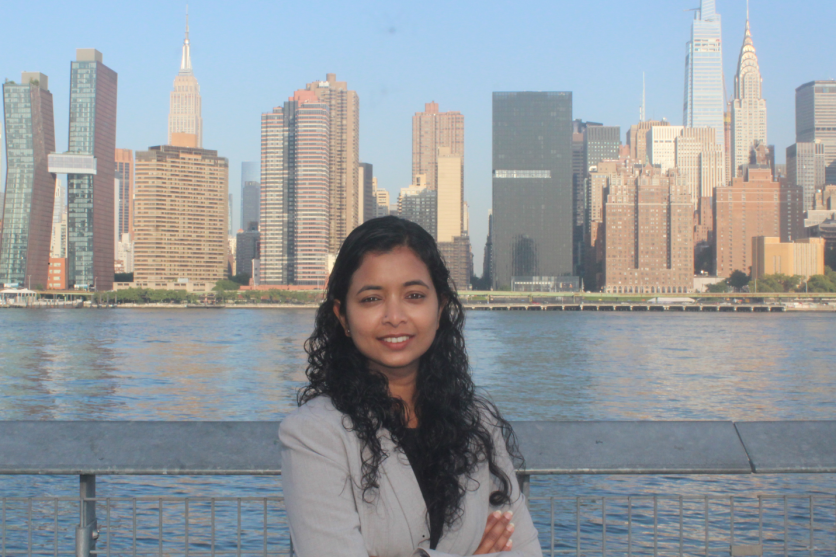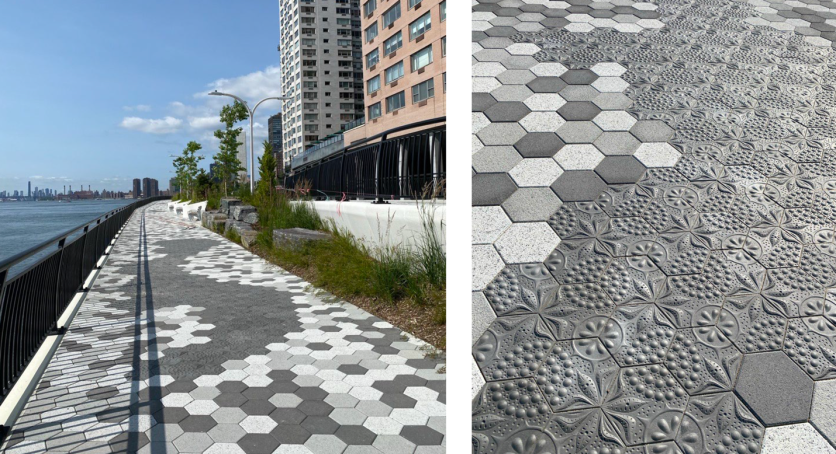
With the rapid pace of industrialization and escalating climate challenges, sustainable urban development has become an urgent priority worldwide. Cities face mounting pressures to reconcile growth demands with environmental stewardship, casting sustainability as a fundamental necessity rather than a mere preference.
Ankita Nalavade, an architect-turned-urban planner, emerges as a prominent advocate of sustainable urban environments. Her approach transcends traditional methods, embedding a comprehensive understanding of social and environmental issues into her projects. Her endeavors, such as the East Midtown Greenway and the East Side Coastal Resiliency Project, demonstrate a commitment to creating resilient and sustainable urban spaces. Ankita's work emphasizes that sustainability is intertwined with social, economic, and environmental dimensions, setting the stage for a shift towards embracing these principles in urban planning.
Green Innovation at the Heart of East Midtown Greenway
As Project Director for the East Midtown Greenway (EMG), Ankita played a key role in bringing a long-term vision for Manhattan's waterfront to life. The EMG forms a vital 0.3-mile stretch of the 32-mile greenway loop, designed to provide an uninterrupted waterfront pedestrian and bicycle path around the island. Located in a densely populated neighborhood where residential buildings line the water's edge, the EMG stands out for its use of caissons, setting the greenway on the outboard of the East River shoreline.
More than just a physical structure, the project prioritizes sustainability across social, economic, and environmental dimensions. "First and foremost, this project catered to the social sustainability of the neighborhood," Ankita shares, pointing to amenities like water fountains, benches, and bike paths that make the space accessible and functional for the community. Beyond social impact, the project leverages cutting-edge technology, including silva cells, to support tree growth on the esplanade and mitigate heat impacts. With future climate challenges in mind, the team established a design flood elevation that ensures the esplanade will withstand sea-level rise, making it resilient for decades to come.
Sustainability in Large-Scale Urban Projects
In large-scale urban projects like the East Side Coastal Resiliency project, Ankita emphasized the importance of using third-party sustainability frameworks, such as LEED, Envision, and WEDG. These frameworks provided a structured approach to achieving holistic sustainability by fostering collaboration among different stakeholders and experts. For instance, the Envision framework offers 64 measurable sustainability and resilience indicators across five categories—ensuring the project team can focus on areas such as Quality of Life, Leadership, and Resource Allocation while setting concrete goals and tracking progress.
Ankita also highlighted the flexibility of these frameworks, noting they can be tailored to fit projects of various scales, helping teams compare data and refine strategies. One of her successful tactics was setting a specific sustainability award goal, such as aiming for an Envision Platinum certification. "The project team members can decide on which sustainability indicators they would like to focus on to achieve that award level," Ankita shared, allowing the team to innovate and leverage their expertise to meet the project's ambitious sustainability targets.

Overcoming Challenges in Implementing Sustainability
Managing large infrastructure projects presented various challenges, particularly in integrating sustainability into long-lasting infrastructure. Ankita emphasized the critical need for a culture shift in the design and construction industry, moving away from the traditional linear economy where resources are discarded at the end of their lifecycle. She noted that the transition to sustainable practices is a steep yet essential learning curve, requiring collaboration, brainstorming, and, at times, difficult conversations among project teams.
One of the biggest hurdles was overcoming resistance from teams who worried that sustainability measures would delay schedules and inflate costs. Ankita, however, stressed the importance of seeing upfront sustainability investments as long-term benefits, explaining, "It's crucial that we see upfront costs related to incorporating sustainability and resilience as a long-term investment for tomorrow's future." Rather than treating sustainability as a separate aspect, Ankita's approach ensured it became an integral part of every project decision, embedding resilience into the core of the facility's design and construction.
Cutting Carbon Footprints
In developing the Circular Construction Guidelines, Ankita and her team focused on reducing embodied carbon through adaptive reuse and innovative material sourcing. She noted that while the concept of embodied carbon is relatively new to the construction industry, many projects have already been applying these principles without measuring their impact. "This is what makes data collection and analysis of projects over time important in circular construction," she explained, highlighting the importance of monitoring long-term effects.
A critical element of reducing embodied carbon was the seamless communication between design and construction teams. "Construction teams are material experts and can help determine ways in which existing buildings can be deconstructed or if the materials can be reused," Ankita shared. The Circular Construction Guidelines also encouraged the use of low-carbon materials, such as the CMU blocks developed in NYC, which incorporate sequestered carbon. By integrating global expertise and innovative technologies like drones for material scanning, the guidelines created a forward-thinking approach to sustainable urban infrastructure.
Pillars of Success in Urban Planning
Ankita believes that sustainability and resilience are inseparable in urban development. She explains, "Sustainability is how we meet the needs of the present without compromising the needs of future generations," while resilience is the ability to "withstand and recover from impacts of existing and ongoing climate change." These principles are evident in her work on the East Side Coastal Resiliency (ESCR) project, a crucial segment of New York City's Big U initiative, which integrates flood protection with public parks and amenities, offering both functionality and community benefits.
For Ankita, success in these projects hinges on understanding the full life cycle of every material. She highlights the importance of using materials that can withstand extreme weather while supporting local ecology, ensuring that they are sustainable not just in day-to-day use but also during climate events. "Using strong pavement materials that withstand flood will also alleviate replacement of pavement," she adds, stressing the need for long-term maintenance planning. By designing projects like ESCR for both immediate use and future climate challenges, Ankita ensures that sustainability and resilience work hand in hand.
Collaborations for Urban Project Success
Collaborations with non-profit organizations and academic institutions have been vital to the success of the urban development projects Ankita has led. These partnerships provide access to cutting-edge solutions while giving students and researchers opportunities to apply their skills to real-world infrastructure challenges. For instance, Ankita highlights a collaboration between the Port Authority of New York and New Jersey and academic researchers, which led to the development of a low-carbon concrete mix, significantly reducing embodied carbon and greenhouse gas emissions in PA projects. "These collaborations often result in benefiting both parties," Ankita explains, emphasizing the mutual advantages of such partnerships.
In New York City, the powerful network of nonprofits plays a key role in connecting agencies with the communities they serve. Ankita's work on the East Side Coastal Resiliency project exemplifies this, with non-profits acting as intermediaries to ensure community needs were addressed throughout the design and construction phases. By phasing construction to keep sections of the project open for public use and holding community meetings on sustainability efforts, the project maintained strong engagement and met local needs. Such collaborations ensure that urban developments are not only sustainable but also deeply rooted in community-driven solutions.

Measuring Long-Term Sustainability Impact
Measuring the long-term impact of sustainability in urban projects requires a comprehensive approach, as Ankita highlights through her work at the Solar One Environmental Education Center. To anticipate the benefits of sustainability measures before a project is fully operational, Ankita relies on a Life Cycle Cost Benefit Analysis (LCCBA), which evaluates both environmental and social factors. "LCCBA combines traditional Life Cycle Cost Analysis with a broader consideration of benefits," Ankita explains, helping teams assess whether their sustainability measures will provide lasting value over the project's entire life cycle.
For projects like the East Side Coastal Resiliency (ESCR), where flood protection is critical, the biggest measure of success is risk reduction and cost savings from avoiding future recovery expenses. Ankita points to the ESCR project's benefit-cost ratio (BCR) of 1.47 as a strong indicator of its positive impact. By optimizing operational energy through strategies like solar photovoltaic panels and efficient building design, projects can generate long-term savings while reducing their environmental footprint. Ankita's approach demonstrates that careful, data-driven analysis is key to ensuring urban developments are both sustainable and resilient for years to come.
Lessons for Future Sustainable Cities
Reflecting on her work in high-profile urban development projects, Ankita emphasizes the importance of setting ambitious goals and maintaining persistence to achieve them. One key lesson she's learned is that bold targets, such as reducing 50% of the embodied carbon in projects by 2033, may initially seem daunting but become attainable with sustained effort. "The ambitious goal is set, now the task is to keep this goal in mind and be persistent in achieving it," she explains, underscoring the value of long-term commitment in the face of challenging sustainability objectives.
Ankita also highlights the importance of teamwork in creating resilient urban spaces. Collaboration and persistence are essential not only for setting goals but for making them a reality. With this mindset, she believes that what may seem like "a mammoth goal now will appear very tiny and achievable" as progress is made, driving the future of sustainable urban development forward.
Ankita's journey highlights her dedication to creating vibrant, sustainable urban futures through projects like the East Midtown Greenway and East Side Coastal Resiliency project. Her focus on reducing carbon footprints and fostering inclusive, green spaces sets a powerful example for addressing modern urban challenges. By advocating for ambitious goals and resilient efforts, Ankita emphasizes the need for collaboration and cultural shifts in urban planning. Her forward-thinking strategies demonstrate the potential for transformative change, positioning sustainability as a cornerstone for crafting resilient cities in the face of climate change.




